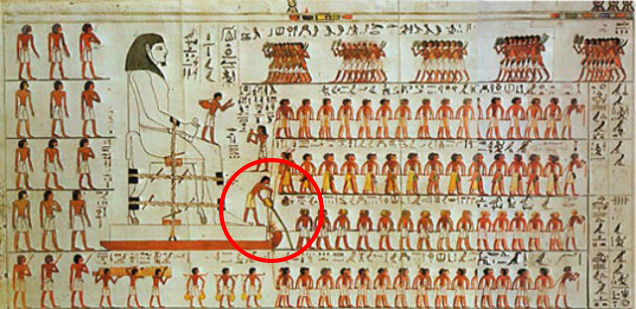Scientists Discovered The Secret To How Ancient Egyptians Moved The Giant Pyramid Stones
April 30, 2014

The question of just how an ancient civilization—without the help of modern technology—moved the 2.5 ton stones that made up their famed pyramids has long plagued Egyptologists and mechanical engineers alike. But now, a team from the University of Amsterdam believes they've figured it out, even though the solution was staring them in the face all along.
It all comes down to friction. See, the ancient Egyptians would transport their rocky cargo across the desert sands, from quarry to monument site with large sleds. Pretty basic sleds, basically just large slabs with upturned edges. Now, when you try to pull a large slab with upturned edges carrying a 2.5 ton load, it tends to dig into the sand ahead of it, building up a sand berm that must then be regularly cleared before it can become an even bigger obstacle.
Wet sand, however, doesn't do this. In sand with just the right amount of dampness, capillary bridges—essentially micro-droplets of water that bind grains of sand to one another through capillary action—form across the grains, which doubles the material's relative stiffness. This prevents the sand from berming in front of the sled and cuts the force required to drag the sled in half. In half.
As a UvA press release explains:
The physicists placed a laboratory version of the Egyptian sledge in a tray of sand. They determined both the required pulling force and the stiffness of the sand as a function of the quantity of water in the sand. To determine the stiffness they used a rheometer, which shows how much force is needed to deform a certain volume of sand.
Experiments revealed that the required pulling force decreased proportional to the stiffness of the sand...A sledge glides far more easily over firm desert sand simply because the sand does not pile up in front of the sledge as it does in the case of dry sand.
These experiments served to confirm what the Egyptians clearly already knew, and what we probably already should have. Artwork within the tomb of Djehutihotep, which was discovered in the Victorian Era, depicts a scene of slaves hauling a colossal statue of the Middle Kingdom ruler and in it, a guy at the front of the sled is shown pouring liquid into the sand. You can see it in the image above.
Click Here For The Most Popular On Sunny Skyz
 Boy With Down Syndrome Nails The Whitney Houston Challenge, And The Crowd Goes Wild
Boy With Down Syndrome Nails The Whitney Houston Challenge, And The Crowd Goes Wild
 Husband Rents Mall Store To Share His Late Wife's Beloved Christmas Display
Husband Rents Mall Store To Share His Late Wife's Beloved Christmas Display
 The ŌĆśGrandma StandŌĆÖ Is Bringing Comfort And Connection, One Conversation At A Time
The ŌĆśGrandma StandŌĆÖ Is Bringing Comfort And Connection, One Conversation At A Time
 LoweŌĆÖs Staff Refuse To Give Up On Missing Cat, Find Her 85 Miles Away
LoweŌĆÖs Staff Refuse To Give Up On Missing Cat, Find Her 85 Miles Away
 This Priest Secretly Became A Masked Wrestler To Fund An Orphanage
This Priest Secretly Became A Masked Wrestler To Fund An Orphanage
 The Kindness Continues For These Two Kings Who Went Viral
The Kindness Continues For These Two Kings Who Went Viral
 She Was Ready For A Fight With Her Neighbor. His Response Changed Everything
She Was Ready For A Fight With Her Neighbor. His Response Changed Everything
 Texans Owner Gets Left Hanging On Live TV ŌĆö What The Media Team Did Next Is Hilarious
Texans Owner Gets Left Hanging On Live TV ŌĆö What The Media Team Did Next Is Hilarious
 Trail Cam Reveals Secret Meeting Spot For Wild Animals
Trail Cam Reveals Secret Meeting Spot For Wild Animals
 After 2 Years Apart, Siblings In Foster Care Are Finally Reunited
After 2 Years Apart, Siblings In Foster Care Are Finally Reunited
 Dad Jokes With Tom Hardy And His Dad
Dad Jokes With Tom Hardy And His Dad
